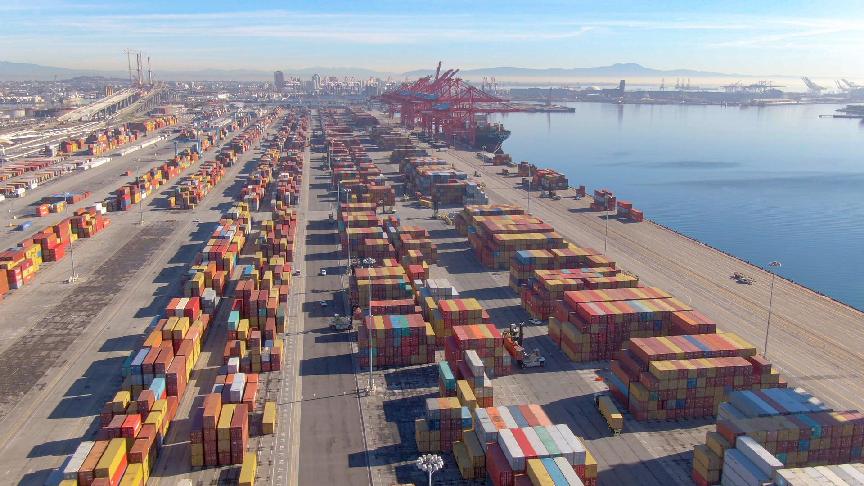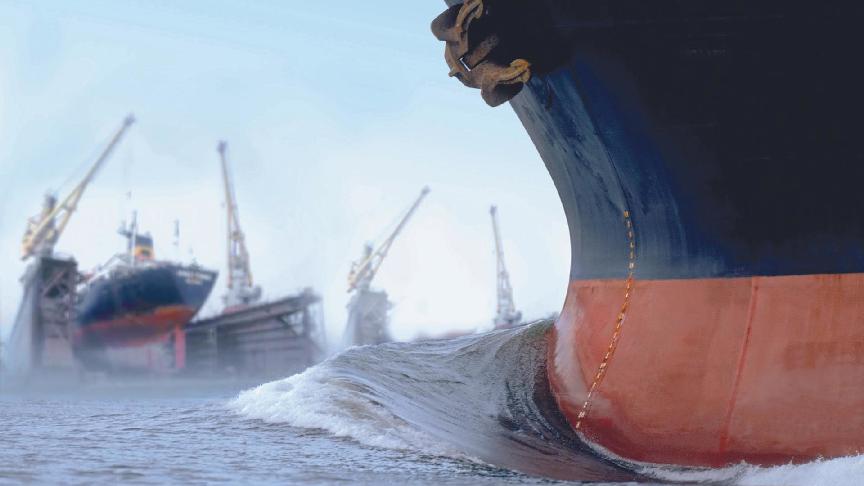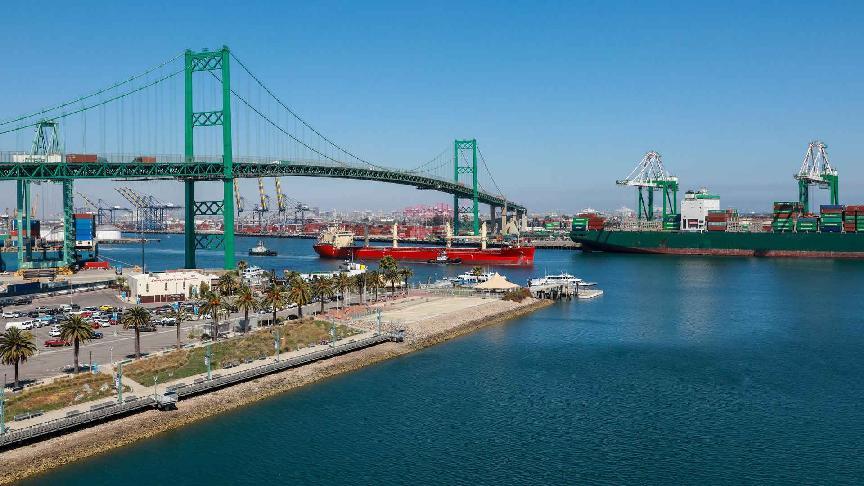17 July (Lloyd's List) - SINCE the advent of containerisation, the pendulum of trade has swung back and forth between the US west coast ports on one side and the east and Gulf coast ports on the other.
The future appears to favour the east, but there are two big questions — one short-term, one long-term:
Will the International Longshoremen’s Association, which represents dockworkers at east and Gulf coast terminals, go on strike in October?
And is the recent drought affecting the Panama Canal a sign of further climate-related restrictions of service from Asia to the Atlantic Basin in the years ahead?
Structural changes and coastal import flows
Eastern ports dominated during the early decades of containerisation.
According to historical data from the Bureau of Transportation Statistics, east and Gulf coast ports still handled two-thirds of US imports in the early 1980s. The west coast did not take the lead until 1989.
Then came the flood of imports from Asia, with China joining the World Trade Organization in 2001. According to data from independent analyst John McCown, west coast ports handled 56.7% of US imports in 2015.
Asian cargo flows to the east and Gulf coasts were hindered by the size of the original Panama Canal locks until 2016. That year, the larger neopanamax locks debuted, facilitating more efficient transport of Asian containerised goods to the Atlantic Basin.
The majority of American consumers reside in eastern states. It makes more sense logistically to unload at east and Gulf coast ports and use trucking to bring goods inland.
West coast discharges of cargo bound for eastern states involves transcontinental rail.
McCown’s data shows a decline of the west coast’s share ever since the neopanamax locks opened for business. Of the top 10 US ports, the west coast ports accounted for 47.5% of imports this May, versus 57% in January 2017.
McCown’s linear regression analysis from January 2017 to May 2024 shows that “over the seven-year period, there has been a 10% shift in coastal preferences [away from the west coast] — the equivalent of 140 basis points per year”.
The containership orderbook implies further structural momentum for the east and Gulf coast ports.
Liner operators used their Covid-era windfall to rejuvenate fleets with an unprecedented wave of new orders. Neopanamax vessels are their most popular newbuild choice, by far.
According to data from Alphaliner, 51% of new containership deliveries year to date through to mid-June 2024 were in the 12,800 teu to 16,600 teu size range.
As more neopanamaxes hit the water, liner operators will be able to increase their per-ship capacity on the Asia-east coast route via the Panama Canal, further reducing their unit costs.
Liner operator Zim is a case in point: its average vessel capacity in the Asia-east coast lane has sharply increased this year, due to newbuilding arrivals.
Temporary issues affecting coastal mix
There have also been several instances of temporary shifts in recent years, in addition to the underlying structural changes driven by the Panama Canal and US demographics.
McCown’s data shows a sharp increase in west coast momentum during the second half of 2020 and first half of 2021, followed by a reversion toward east and Gulf Coast ports in mid-2021 to mid-2023, then another reversal in momentum in favour of the west coast in 4Q23 and 1Q24.
The 2020-2021 swing to west coast ports was driven by Covid. US shippers opted for the shorter, more direct ocean route to Southern California as import demand suddenly spiked during the early months of the pandemic boom.
That strategy proved unsustainable, however, as Los Angeles and Long Beach were overwhelmed by congestion. US importers then turned to the other coastlines by necessity.
It was an expensive switch. While the majority of imports are on long-term contract, shippers were forced to use the spot market more during the supply chain crisis.
This increased their exposure to the coastal spot-rate spread — the premium of Asia-east coast spot rates over Asia-west coast spot rates.
The Shanghai Containerised Freight Index shows that this spread hovered around $1,000 per feu prior to Covid. It shot up at the beginning of May 2021.
By the week of September 24, 2021, the premium for spot cargo from Shanghai to the US east coast versus the west coast hit an all-time high of $5,654 per feu.
The spread did not return to its normal level of around $1,000 per feu until March 2023.
The trend toward the east and Gulf coast ports during the second half of 2022 and the first three quarters of 2023 was precipitated by congestion in Los Angeles and Long Beach.
But it was solidified and intensified by another driver: fear of a strike by the International Longshore and Warehouse Union, which represents west coast dockworkers.
Labour unrest on the west coast had caused major disruptions before, in 2002 and 2014-2015.
The latest concerns proved unfounded. The ILWU and terminal employers announced a tentative agreement on June 14, 2023, and coastal momentum shifted yet again.
The import swing back toward the west coast in 4Q23 and 1Q24 likely had a number of drivers.
First, the all-clear on labour unrest on the west coast. Second, temporary draught and transit restrictions in the Panama Canal. And third, Houthi attacks in the Red Sea.
Several Asia-east coast services that had previously used the Panama Canal were forced to use the Suez Canal, due to low water levels in Panama. Those voyages were then rerouted a second time by Houthi attacks, via the Cape of Good Hope.
Diversions caused the east coast-west coast spot-rate spread to widen again. In late January 2024, it hit $2,000 per feu. It reverted back to normal levels in late March and has remained at around $1,000 per feu since then.
Transit restrictions in the Panama Canal also had a significant — albeit temporary — effect on Asia-east coast service, a positive for the west coast.
According to data from the Panama Canal Authority, the number of transits of neopanamax containerships declined from 164 in October (the last month before restrictions) to a low of 118 in January — a drop of 28%.
As with the spot-rate spread, this too has normalised. There were 162 neopanamax containership transits in June, up 37% from the January nadir — and only two transits below October’s tally.
The next big potential flashpoint for the coastal-mix saga: the threat of an ILA strike only a month before the presidential election.
On May 13, the ILA and the employers’ group, the US Marine Alliance (USMX), expressed confidence that a deal would be reached by the end of the current contract on September 30.
But on June 11, the ILA walked away from talks, citing APM Terminals’ use of an automated gate system.
On a positive note, the resolution of another issue was announced June 25.
South Carolina Ports and the ILA confirmed an agreement for the reopening of the Leatherman terminal in Charleston, a newly constructed facility that
has been dormant since its completion in 2021, due to a dispute over non-union labour.
The situation then took another turn for the worse on July 12, when the ILA warned “the threat of an October 1 strike is growing more likely”.
Gene Seroka, executive director of the Port of Los Angeles, noted there has been some positive effect on west coast volumes due to recent issues, but he downplayed the significance.
There has been “no real kneejerk reaction” to the ILA strike threat, he said during a press conference on June 13.
“Folks have shifted fractional amounts of their allocations to Los Angeles as a hedge, whether it’s because of security concerns in the Red Sea, restrictions due to the drought in Panama, or ongoing negotiations between the ILA and USMX. But nothing huge. No big surge.”
And, beyond the various temporary drivers, the structural thesis favouring the east and Gulf coast ports remains intact.
McCown said in an interview with Lloyd’s List: “All of these events have been kind of like a sine wave that goes up and down, but underneath that, there has been a constant eastward movement — and I don’t see anything stopping that.
“It’s like the antithesis of Horace Greeley’s ‘Go West, young man.’ It’s ‘Go east with your boxes for better economics’.”







